Embarking on our quest for the world’s most romantic and sustainable destinations, our journey takes us to the breathtaking Osa Peninsula in Costa Rica. Known for its progressive environmental policies, Costa Rica has earned its reputation as an eco-friendly haven. With 25% of the country’s land protected as nature reserves, an impressive reforestation effort that covers 53% of its territory with forests, and a remarkable reliance on 99% renewable energy sources, Costa Rica is an ideal destination for a sustainable honeymoon. Among its many stunning locations, none rival the Osa Peninsula in terms of both romance and sustainability.
Renowned as one of the top five most romantic destinations worldwide by National Geographic, the Osa Peninsula boasts an astonishing 2.5% of the Earth’s biodiversity within a minuscule fraction of its total surface area. It is rightfully hailed as “the most biologically intense place on earth.” With vast wetland ecosystems, thriving mangrove forests, and the largest remaining tract of lowland rainforest in Pacific Mesoamerica, not to mention its pristine beaches, the Osa Peninsula offers an unrivaled experience. During our week-long stay in this enchanted corner of southwestern Costa Rica, we immersed ourselves in an array of activities, including hiking, birding, kayaking, swimming, and engaging with the passionate individuals who contribute to making the Osa Peninsula a dream destination. Join us as we present a comprehensive sustainable travel guide to help you plan your perfect getaway.
Sierpe River Ride:
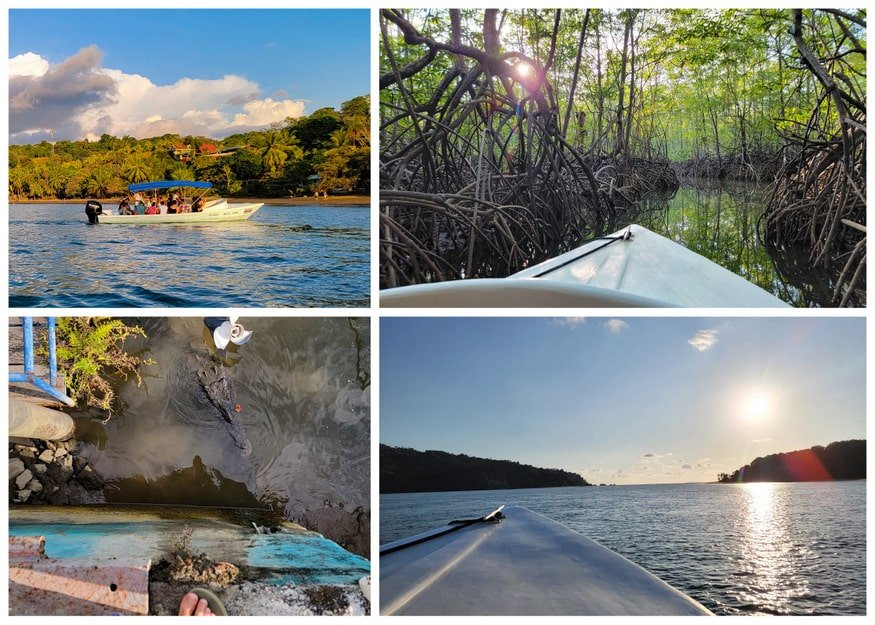
Our journey to the Osa Peninsula began by meandering down the Pacific Coast, visiting friends in Guanacaste, indulging in island glamping in the Gulf of Nicoya, chasing waterfalls in Dominical, and finally making our way to Drake Bay in the Osa Peninsula. Due to the challenging road access to the northern half of the peninsula, we discovered that the most enjoyable and adventurous route is via boat from the river town of Sierpe. Arriving at the dock, we were greeted by our 20-foot covered boat, accompanied by a crocodile half its size. This was no ordinary water-taxi ride; it was an hour-long safari.
The Sierpe River, known as the Serpent River in Spanish, derives its name from its snakelike path through the rainforest. Our captain skillfully maneuvered the boat towards a dense wall of mangroves, seemingly headed for an imminent collision. However, we soon discovered a narrow opening that led us through a thicket-lined alleyway. With only a few feet on each side, we gently navigated our way through the maze and emerged into the open ocean. Cruising along the lush shoreline, weaving between majestic sea stacks, we marveled at the sailboats gently bobbing in Drake Bay. As our captain skillfully approached the shore, he instructed us to roll up our pants, carry our bags on our heads, and wade our way to Playa Colorada. Welcome to Bahía Drake!
Drake Bay:
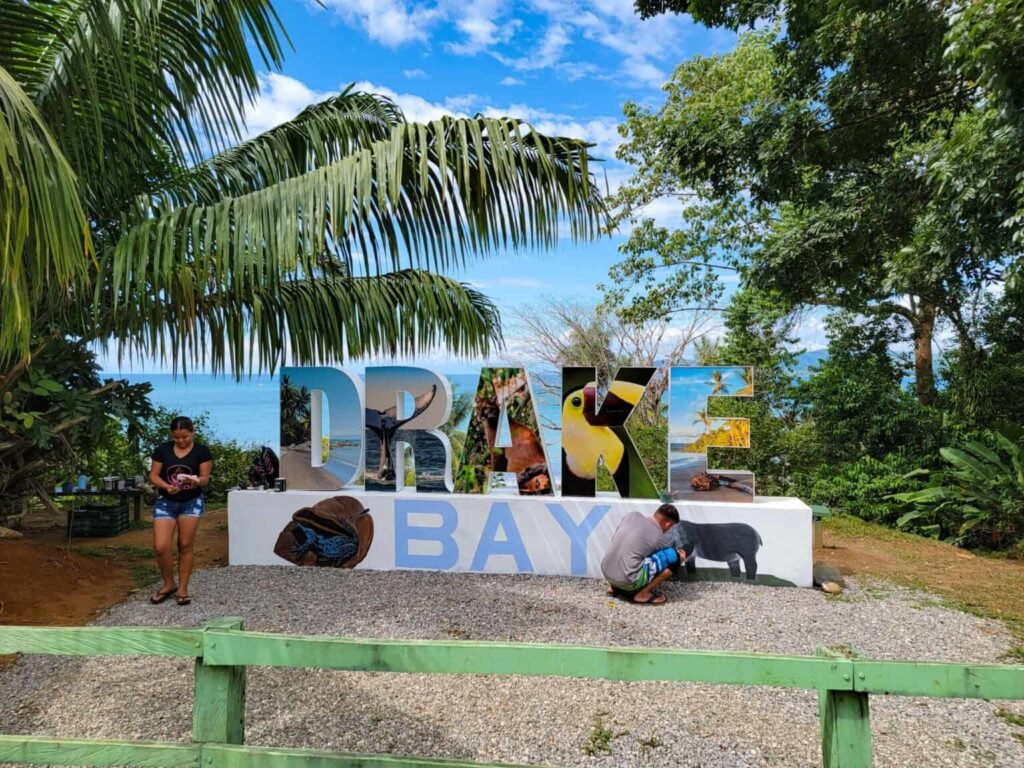
The town of Drake Bay consists of a main street that climbs uphill, dotted with a few restaurants, outfitters, and basic guest houses. However, if you venture farther along the beach and into the hills, you’ll discover eco-resorts nestled amidst the trees and secluded coves. The individuals strolling along the beach represent a mix of boho backpackers, wildlife photographers clad in khaki attire, seasoned fishermen, and starry-eyed couples. Cars are an uncommon sight here, as the best way to navigate the area is through trails and boats.
Drake Bay Hiking Trail:

With a staggering annual rainfall of 134 inches, it was no surprise to wake up to a tropical downpour. We spent the morning tending to my broken computer (Mike disassembled it into 50 pieces in a valiant attempt to save our digital lifeline) until the sun beckoned us outside for a must-do adventure: the Drake Bay Hiking Trail. This 12.5-mile round-trip trail can be made more leisurely by opting to take a boat back from Playa San Josecito or by hiking until you find the beach that captivates your heart.
As we marveled at towering bamboo, crossed suspension bridges, and paused to observe swinging Capuchin monkeys, we leisurely made our way to Cocolito Beach. Walking along the golden sand, passing couples building sandcastles and immersed in paperback novels, we scaled black rocks to uncover a hidden cove. The rock formations appeared as rough-hewn sculptures emerging from the sea, hosting tide pools and cliffs that gave rise to dramatic crashing waves. With soft sand underfoot, freshly fallen coconuts, and a picnic blanket, we relished in the idyllic setting of a romantic beach day.
More to Explore in Drake Bay:
Caño Island: Embark on a boat trip to this biosphere reserve, where you can spot dolphins and whales along the way. Upon arrival, snorkel around a vibrant reef teeming with colorful fish. Uninhabited and protected for its flora, fauna, and archaeological significance as a Pre-Columbian burial ground, Caño Island offers a truly immersive experience.
Night Walk: With over 60% of Osa’s wildlife active during the night, embarking on a nocturnal adventure allows you to encounter species that would otherwise remain unseen. Join a tour with “Tracie the Bug Lady,” a biologist and insect enthusiast, and be treated to fascinating insights and the opportunity to observe vibrant tree frogs, tailless scorpions, red-eyed tree snakes, owl butterflies, praying mantises, sleeping hummingbirds, and more.
Floating Tour on Río Claro: Prepare for a rainforest hike that seamlessly merges with swimming holes at picturesque waterfalls, cliff jumping, and rock hopping. Conclude your adventure with a relaxing retreat at Río Claro Beach. Embark on this exhilarating journey with the experienced guides at Pachenco Tours.
Drake Bay Hotels: The luxurious Drake Bay Getaway boasts a prime location atop a hill overlooking the main beach, and it remains firmly committed to sustainability in accordance with the Paris Pledge for Action. Just a short distance down the hill and along the hiking trail, Aguila de Osa has long been a leader in Costa Rica’s eco-lodges and Osa’s conservation efforts, offering lovely rooms at affordable rates. For an even more secluded experience, a five-minute boat ride from town will transport you to the villas of Copa de Arbol, an excellent all-inclusive option.
Puerto Jiménez:
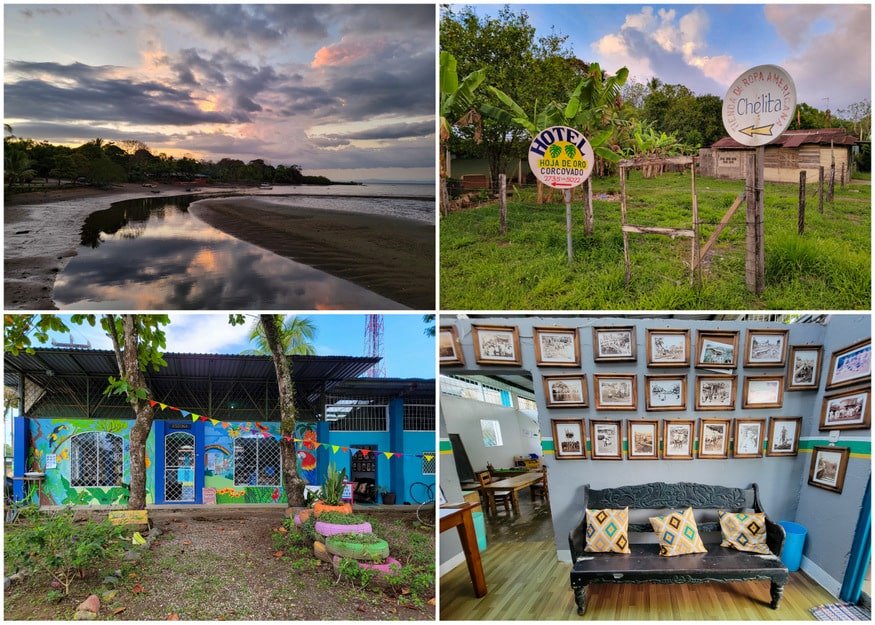
Setting our alarms for 4 a.m., we prepared to embark on the day’s only “collectivo” bus over the mountains to the Gulfo Dulce side and the largest town on the peninsula, Puerto Jiménez. The main street of Puerto Jiménez is reminiscent of any typical Costa Rican town, lined with hardware stores, clothing shops, and banks. However, it also boasts adventure outfitters and guest houses. When we arrived at dawn, nothing was open except for Cafeteria Monka, where tables and chairs were set out. We made ourselves comfortable and watched as the town gradually awakened, beginning with the arrival of scarlet macaws flying in pairs. By quarter to eight, bicycles were buzzing by, and mothers hurriedly guided their children to school.
Due to limited educational resources in the area, the nonprofit organization ASCONA has stepped in to fill the void. ASCONA has established a library and community center, providing a space for families to learn, gather, and engage in creative endeavors. Intrigued, we ventured to ASCONA’s building, adorned with rainforest-inspired murals, and explored their small museum showcasing historic photographs, a children’s art studio, and a boutique featuring handcrafted souvenirs. We had the honor of meeting Ifigenia Canet, the president of ASCONA, and were captivated by her passion for their community programs.
Ifigenia is deeply committed to preserving Osa’s natural beauty by educating locals about the importance of protecting the rainforest for the sake of the planet, their children, and their own livelihoods. Supporting ASCONA through the purchase of their artisan-made souvenirs helps sustain their vital programs. Don’t forget to visit the library and explore Ifi’s community-based tour company, Osa Wild!
Luna Lodge:
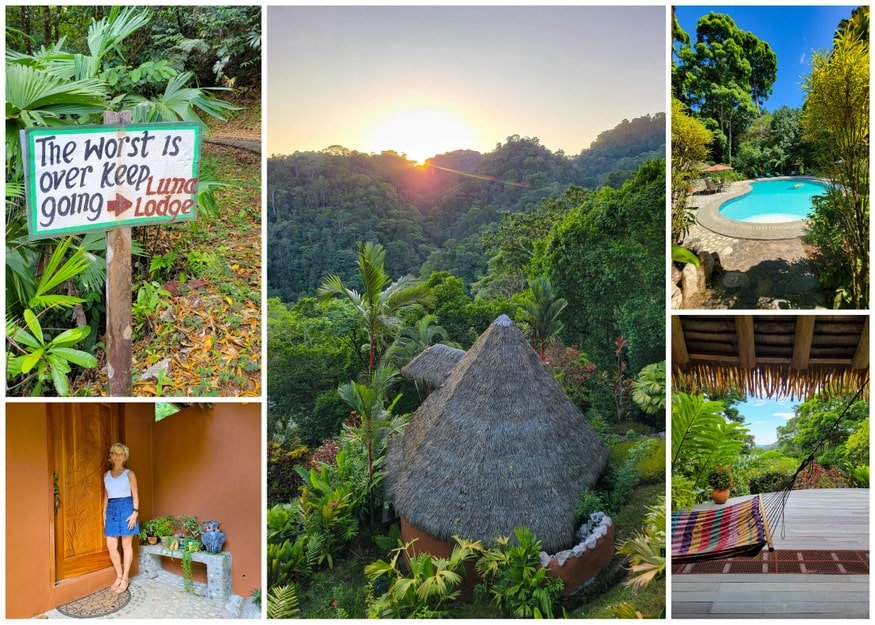
Lana Wedmore, the owner of Luna Lodge, is another influential figure in Osa’s conservation and eco-tourism efforts. Her exquisite hotel holds a five-leaf sustainability rating, offering remarkable wellness programs and a plethora of activities. However, it is her personal story and mission that inspired us to book a four-night stay. The Luna Lodge team picked us up from Puerto Jiménez, and during the drive, we enjoyed an impromptu safari, spotting monkeys, owls, macaws, and various wildlife that would have otherwise gone unnoticed through the tinted windows. The winding road eventually led us to the village of Carate, where we turned onto a dirt road leading to the river valley.
Engaging the four-wheel-drive, our tires climbed over rocks and splashed through streams. We passed a house with a giant sluice-box and encountered an elderly gentleman who clung to memories of Osa’s gold-mining days. The jungle-clad road seemed almost impossibly steep until a sign appeared, reading, “The worst is over, keep going.” How did Lana manage to build atop this mountain? Forty years ago, she studied abroad in Costa Rica before returning in 1991 on a one-way trip from Colorado to the Osa Peninsula. She worked as a tour guide and spent nine years living in a tented camp on the beach directly below her present lodge. It was during this time that an old miner approached Lana, entrusting her with the land, with the hope that she would preserve this sliver of the rainforest. Today, Luna Lodge and the land-conservation nonprofit organization, the White Hawk Foundation, fulfill this vision.
Luna Bungalows:
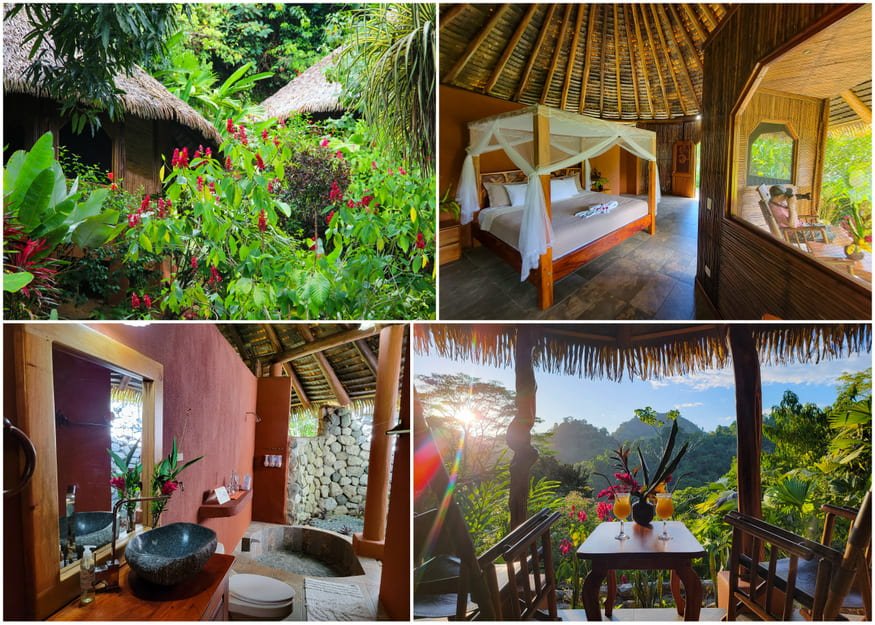
Arriving at the lodge situated on the upper slopes of the Carate River Valley, we were greeted by a grand open-air rancho that serves as the heart of the property. Tropical flowers lined the paths leading to the pool, eight bungalows, three haciendas, seven platform tents, a yoga pavilion, and a spa. Our bamboo bungalow featured oversized screened windows, offering a choice between a cozy four-poster bed, an invigorating open-air shower, or relaxing on the porch’s rocking chairs. The surrounding tree-covered peaks and symphony of bird songs beckoned us to the terrace, signaling the start of our exploration of the lodge’s hiking trails.
The Grounds:
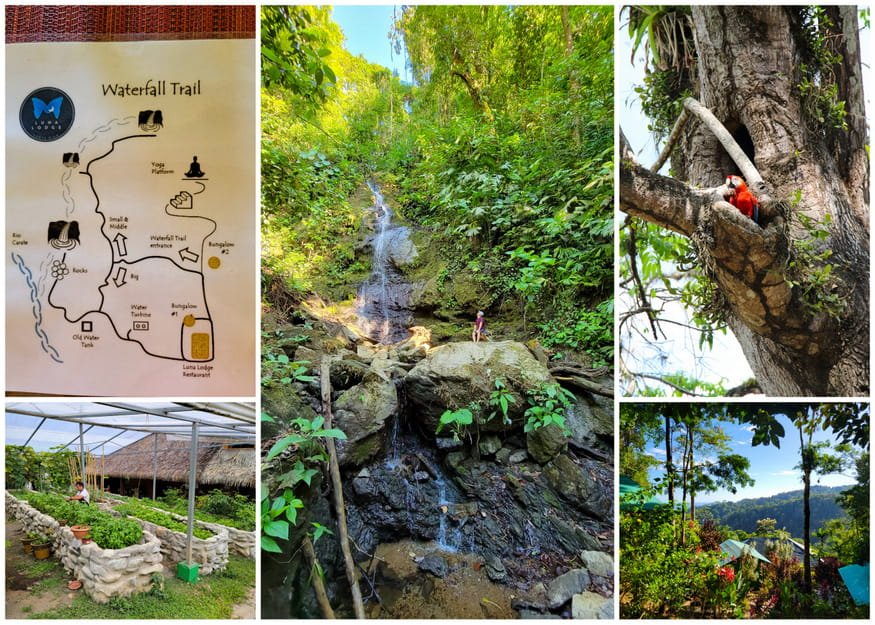
To fully appreciate and explore Luna Lodge’s 60 acres of rainforest, as well as the hundreds of fruit trees and endemic plants nurtured from seeds, we embarked on a journey along their network of trails, adorned with educational signage. Mike and I chose the “Loop of Gold,” which took us from the primary rainforest into the secondary forest. Occasional botanical identifications and inspirational quotes adorned the trail, such as “Look deep into nature, and you’ll understand everything better” or the Spanish equivalent, “Green is the new gold.” Along the way, we encountered water turbines, a solar array, and a permaculture garden that demonstrated how the lodge generates 100% of its power and strives to provide as much of its own food as possible. The trail eventually connected us to the waterfall trail, where we encountered a series of cascades and swimming holes situated right on the property.
Dining:
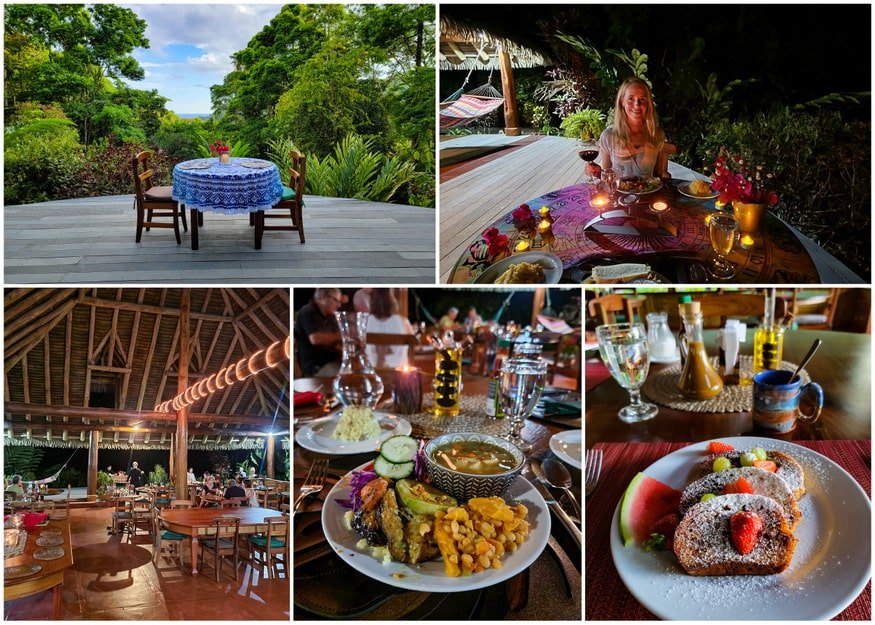
Each evening, we eagerly gathered for pre-dinner appetizers before indulging in a beautiful family-style meal. As a vegetarian and wellness advocate, Lana ensures that organic ingredients are used and that dietary needs are catered to. With 5-7 dishes available each evening, all but one are vegetarian, if not vegan, offering a culinary haven for us. On our anniversary dinner, the staff surprised us with a table set on the balcony, adorned with a pathway of candles, and a personalized vegan cake as the grand finale.
Corcovado National Park:

Rising before the sun, we prepared to embark on an unforgettable adventure: exploring Corcovado National Park, the crown jewel of Osa’s wilderness areas. Corcovado is a testament to the power of conservation. Until the 1970s, logging and gold mining thrived in the area. However, the government made the decision to prioritize environmental preservation over industrial pursuits, transforming Corcovado into a national park. Today, it provides a sanctuary for 500 tree species, the endangered giant anteater, harpy eagles, all of Costa Rica’s big cats, the four native species of monkeys, and Baird’s tapirs, Central America’s largest land mammals. It is truly a wildlife enthusiast’s nirvana.
Exploring the park requires the guidance of a knowledgeable local guide. Visitors can opt for multi-day treks between ranger stations, embark on a boat trip from Drake Bay, or, as Luna Lodge guests, hike directly from Carate beach. Our wildlife sightings began almost immediately, thanks to our guide Marlon’s keen senses. Prior to joining Luna Lodge, Marlon traversed this trail for five hours each day, yearning to observe the wonders of the rainforest. His expertise allowed us to witness hummingbird nests, learn how to imitate toucan mating calls, and discover the medicinal uses of endemic plants. The trail weaved through dense rainforest, occasionally revealing pristine beaches bordered by distant bluffs and sheltered by the verdant canopy above. Our encounters included the vibrant slaty-tailed tragon, a majestic curassow, the yellow-throated toucan, the small yet formidable golden orb weaver spider, and countless monkeys and coatis. However, the pinnacle of our adventure was spotting our first anteater—a northern tamandua peacefully napping in a tree. We savored the moment, enjoying a picnic lunch while observing this captivating creature in its natural habitat.
Kayaking Laguna Pejeperro:
During the afternoon, we took a leisurely break by the pool and retired early, preparing for another memorable day ahead. Before sunrise, we embarked on a kayaking excursion to Laguna Pejeperro, aptly named Fish Dog Lagoon. Walking along the moonlit trail and wading into the dark waters, we momentarily questioned our decision. However, as the sun began to rise, painting the sky with vibrant hues and illuminating the shorebirds that mirrored the scene, any doubts dissipated. Paddling along the edges of the lagoon, we marveled at unusual species such as the “Juevo Frito,” a bird whose call mimics the sizzle of a fried egg, and the “Jesus Christo Lizard,” capable of walking on water. Ibises, egrets, kingfishers, northern jacanas, and various wildlife reminded us why waking up for a sunrise adventure in the Osa Peninsula is always worthwhile.
Preserving Osa:
On our final morning at Luna Lodge, we joined Lana for a yoga class overlooking the ocean, surrounded by trees, and serenaded by the melodic calls of macaws. The experience filled us with gratitude. Following our session, Lana invited us to her house and studio, where she practices massage, reiki, and sound healing. As we stepped into her living room, its open side revealed a panoramic view of the Carate River Valley. This breathtaking vista serves as a daily reminder for Lana to honor and protect this precious place.
Since 2010, Lana has dedicated herself to running the White Hawk Foundation, a land trust aimed at preserving the rainforest and wildlife corridors stretching from the Carate River Valley to the national park. To further support the delicate ecosystem, Luna Lodge actively participates in The Turtle Protection Committee, ASCONA, and The Association of Integral Development of Corcovado. The Osa Peninsula is indeed a fragile paradise, but by supporting businesses and nonprofit organizations that prioritize conservation, we can contribute to its preservation for future generations of visitors and species alike.
Osa Peninsula: Preparing for Your Trip!
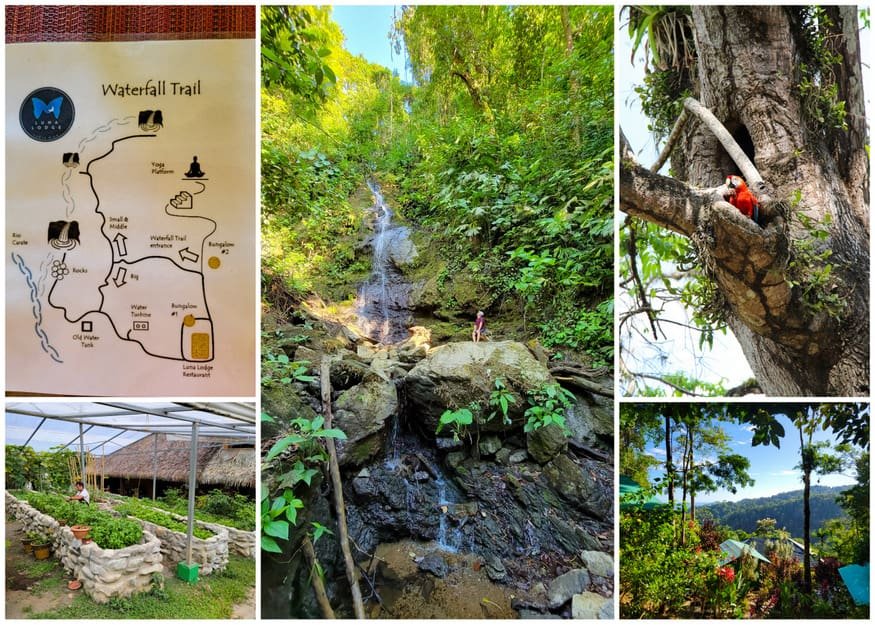
Getting There: To reach Puerto Jiménez, you can take a one-hour SANSA flight from San Jose airport or hop on a Grupo Blanco bus from various coastal towns in Puntarenas. To reach Drake Bay, the most enjoyable and efficient method is to embark on a river boat journey from Sierpe. Although a road connects the two towns, it has infrequent departures that occur pre-dawn and becomes impassable during the rainy season.
When to Go: January to April offers reliably sunny weather with minimal rainfall. From May to August, expect afternoon showers, but enjoy the lush green landscape and reduced lodging rates. It is advisable to avoid September and October when heavy rainfall occurs, causing most accommodations to close for the season.
Travel Insurance: We highly recommend obtaining travel insurance before venturing into this remote and wild part of Costa Rica.
The Osa Peninsula offers a perfect balance between romance and sustainability. As you embark on your journey, immerse yourself in the region’s remarkable natural beauty, support local conservation efforts, and cherish the memories you create. By embracing a sustainable approach, you can ensure that this pristine paradise continues to thrive for generations to come.

